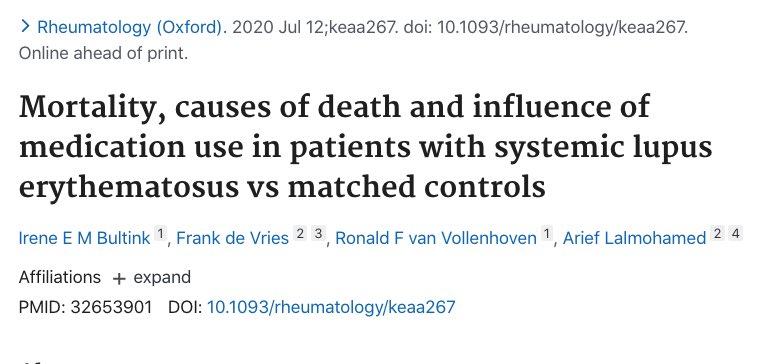Source: PubMed
Abstract
Objectives: We wanted to estimate the magnitude of the risk from all-cause, cause-specific and sex-specific mortality in patients with SLE and relative risks compared with matched controls and to evaluate the influence of exposure to medication on risk of mortality in SLE.
Methods: We conducted a population-based cohort study using the Clinical Practice Research Datalink, Hospital Episode Statistics and national death certificates (from 1987 to 2012). Each SLE patient (n = 4343) was matched with up to six controls (n = 21 780) by age and sex. Cox proportional hazards models were used to estimate overall and cause-specific mortality rate ratios.
Results: Patients with SLE had a 1.8-fold increased mortality rate for all-cause mortality compared with age- and sex-matched subjects [adjusted hazard ratio (HR) = 1.80, 95% CI: 1.57, 2.08]. The HR was highest in patients aged 18-39 years (adjusted HR = 4.87, 95% CI: 1.93, 12.3). Mortality rates were not significantly different between male and female patients. Cumulative glucocorticoid use raised the mortality rate, whereas the HR was reduced by 45% with cumulative low-dose HCQ use. Patients with SLE had increased cause-specific mortality rates for cardiovascular disease, infections, non-infectious respiratory disease and for death attributable to accidents or suicide, whereas the mortality rate for cancer was reduced in comparison to controls.
Conclusion: British patients with SLE had a 1.8-fold increased mortality rate compared with the general population. Glucocorticoid use and being diagnosed at a younger age were associated with an increased risk of mortality. HCQ use significantly reduced the mortality rate, but this association was found only in the lowest cumulative dosage exposure group.
Related:
National Cancer Instititute: List of Active Clinical Trials Using Hydroxychloroquine for Cancer
The Coronavirus Is Man Made According to Luc Montagnier the Man Who Discovered HIV

